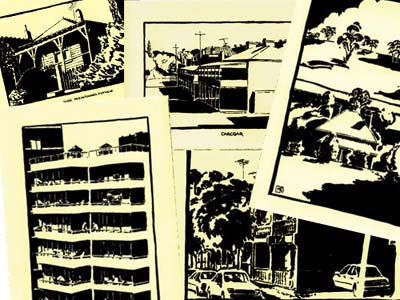
Australian Paintings 2007–10
There is also a page of chiaroscuro (black-white) drawings from the same period
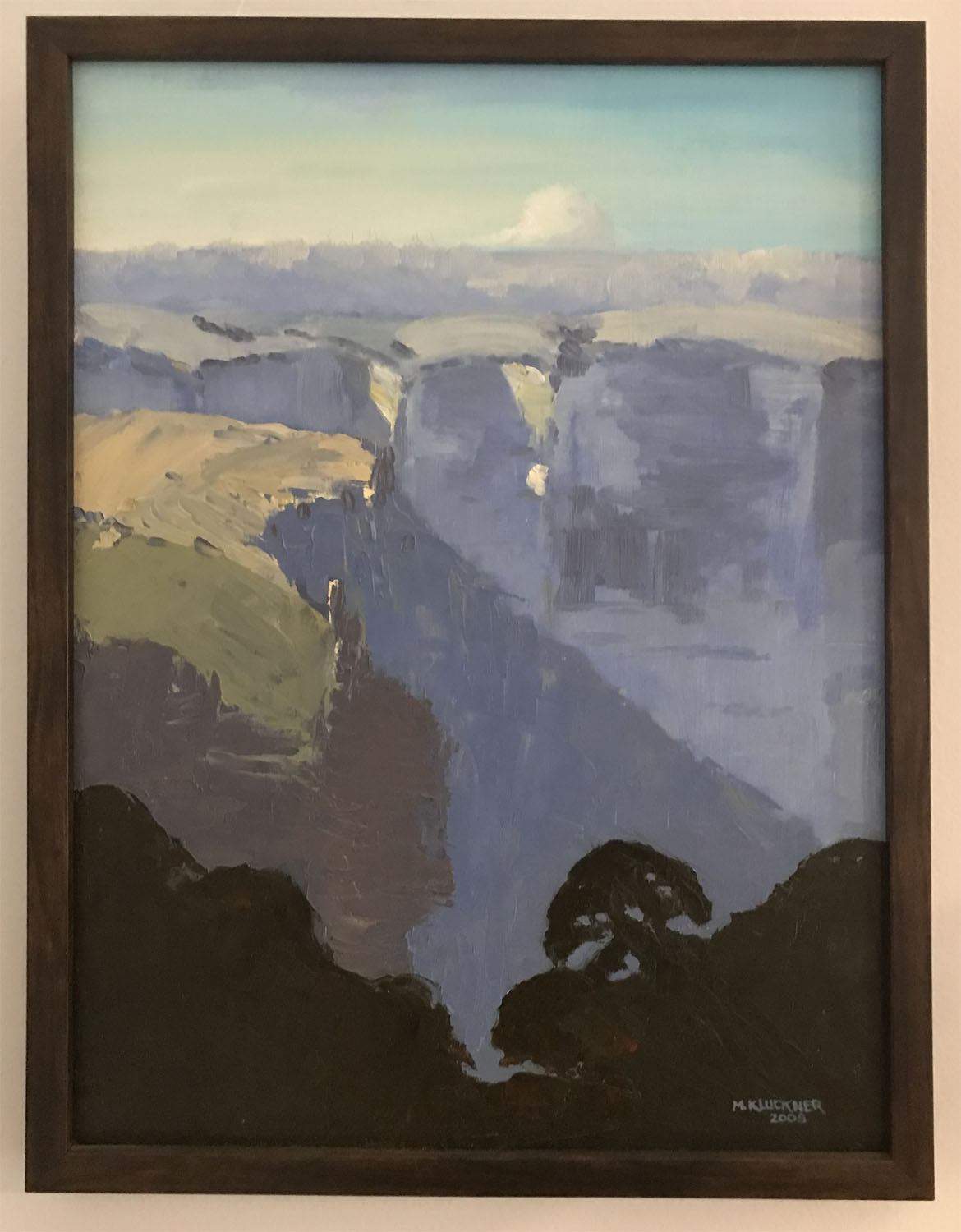
An oil of the Blue Mountains, where we lived for three years.
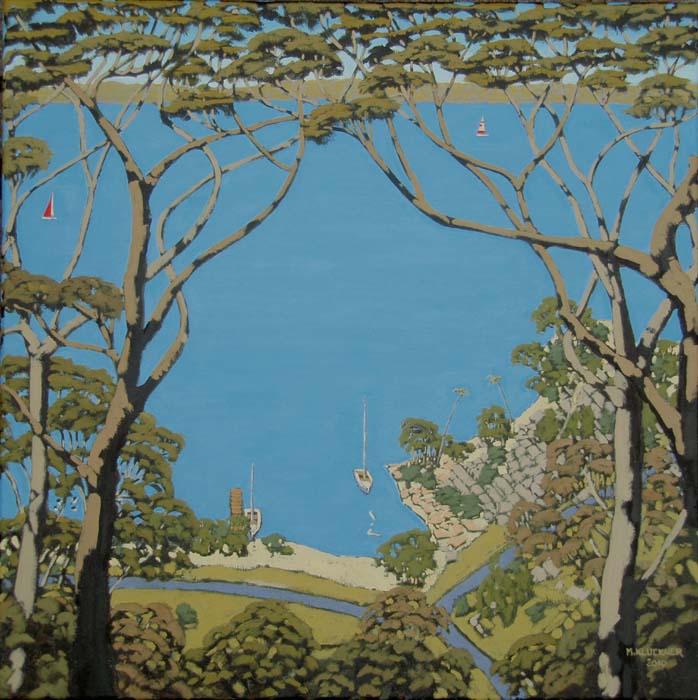
Boreen Point for Jeff (a
commission)
60 x 60 cm. (24 inches square) oil on canvas
| Boreen Point is a
community on a lake near Noosa Heads on the Queensland coast. It
carries an air of utter tranquillity and the colours and heat of
summer. There are many views through layers of eucalypts to the
lakeshore and beyond. The blue in the original is deeper, less cyan, than in this reproduction, the light on the eucalypts and the distant shore keyed higher. |
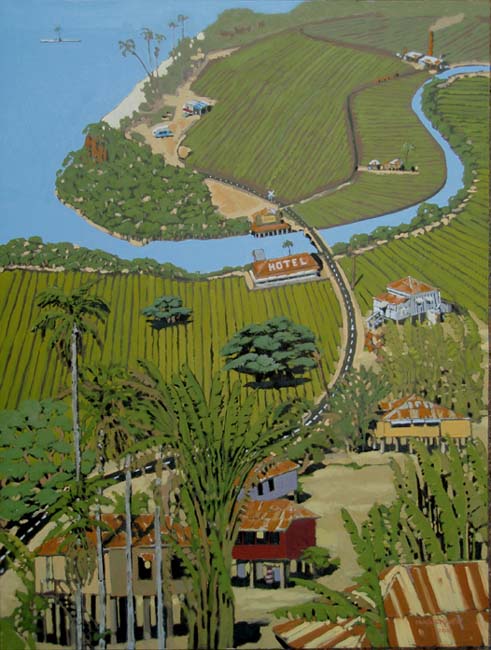 |
North
Queensland Oil on Board (50 x 40 cm, 20 x 16 inches) A painting, like the one of the Outback below, that attempts to roll together all the impressions of travelling in Australia's tropical north. The curious northern architecture of houses on stumps (that is, stilts), sprawling pubs with shaded verandahs, rusting iron roofs, sluggish rivers lined with mangroves, plantations in green strips that might be bananas but more likely are sugar cane, cane mills and narrow-gauge cane railways, palm trees, white sand beaches and, of course, caravan parks like the ones we stayed in on the Great Campervan Trip. Like many of the pictures I'm now painting, I've dispensed with single-point perspective here and am taking a much freer view of the arrangement and scale of objects in the landscape – freer, at least, than what I normally do when I'm out with the sketchbook and "illustrating" things. |
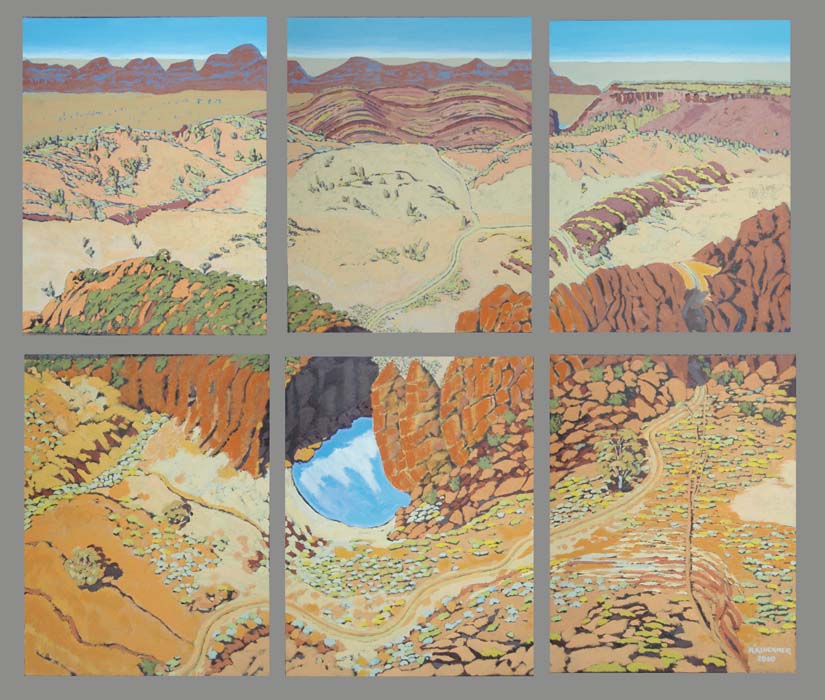
Outback Approximately
6 oil panels, total size approx. 36 x 42 inches (91 x 107 cm), 2010
| An attempt to roll the
entire experience of travelling through the central Australian
desert into one image. As in many Aboriginal "desert
school" paintings, a waterhole is the focus; spinifex and other
low shrubs and bunch-grasses speckle the landscape, as in
Aboriginal dot paintings; the pumpkin-coloured sand dunes,
the yellows, greens and blues of the vegetation, the rock faces
quite orange-coloured in the foreground but fading quickly to
red with purple shadows in the distance due to a trick of light;
the land forms ribbed and arched – the "Caterpillar Dreaming" of
the MacDonnell Ranges near Alice Springs; dirt tracks meandering
like snakes between the rocky outcrops; unlike in Aboriginal
paintings which are painted flat like maps, an evocation of the
vastness and bleakness of the desert, the isolation and
vulnerability a traveller feels and the immense sense of relief
of coming upon a waterhole in a gorge; and finally, as in a
William Robinson landscape, the idea that the water is actually
a hole looking through to the sky. |
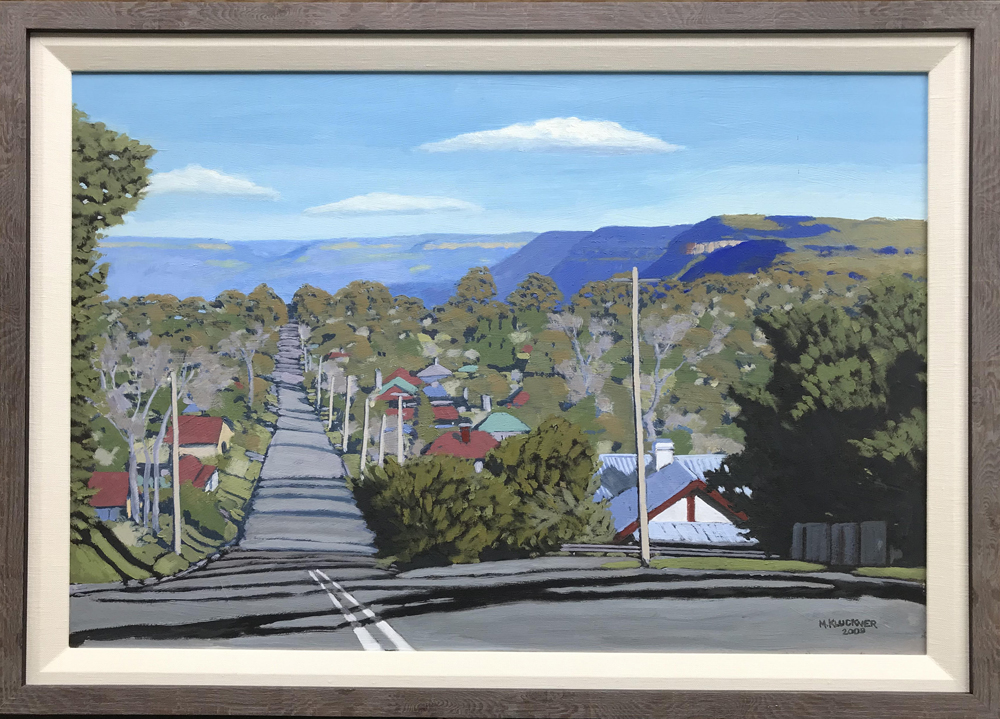
Cascade Street from the top of the hill, oil on board, Winter 2009
(...our view on the way to our Katoomba home from 2007-9)
 Mist Rising in the Kedumba Gully, 2009, oil on canvas, diptych, 61 x 154 cm, 24 x 60 inches This looks back to the first painting I did here in 2007, based on the view that we had from the back window in Katoomba from 2007-9. |
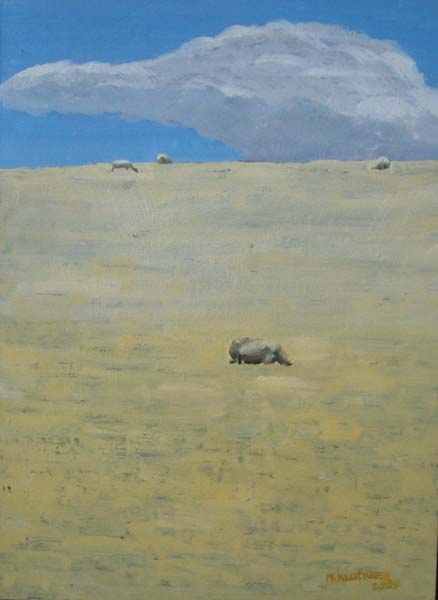 |
Sheep
on hillside 2009 Oil on board 37.5 x 27 cm 15 x 10 3/4 inches |
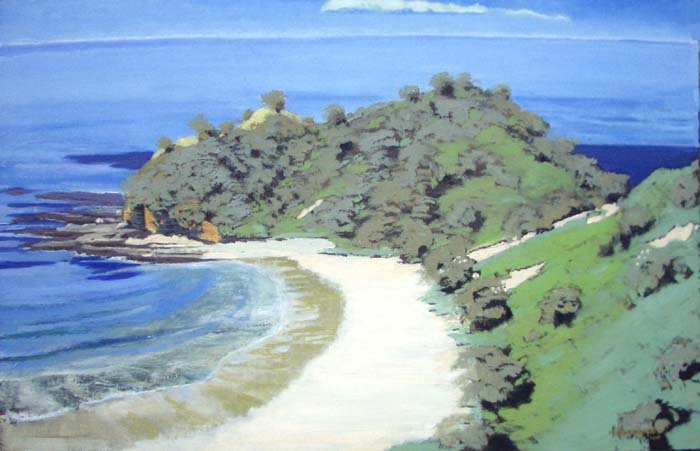 Beach at Nambucca, oil on board, painted 2009: 62 x 41 cm. Can't resist those ocean colours.... 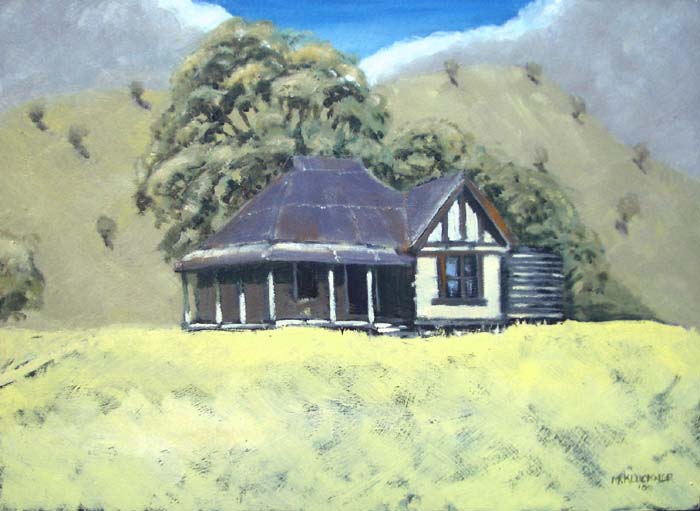 Summer Storm, 2009, oil on board, 37.5 27 cm. Based on a little shack on the roadside on the way to Hill End. |
Recent (2008) sketchbook watercolours
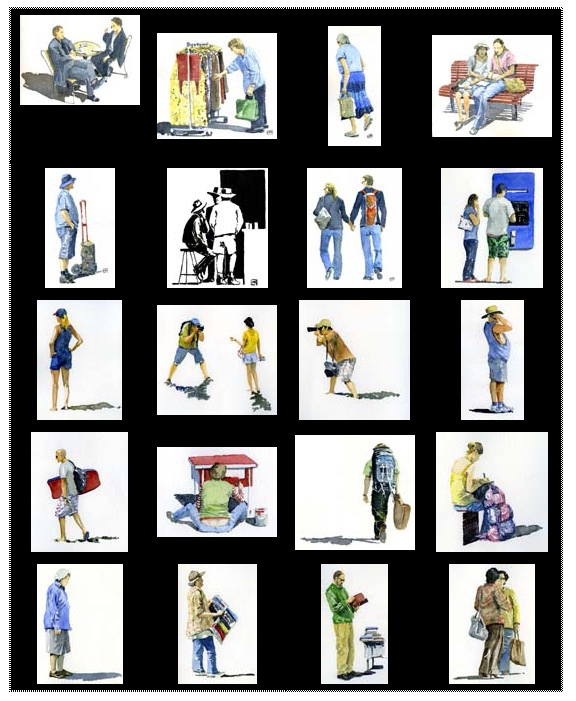
People in the sketchbook: a few of these went into my book Here & Gone.
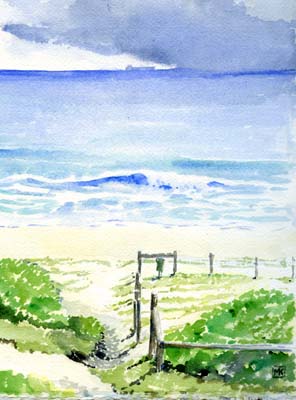 |
As
the months have gone by here and we've travelled around the
countryside, I've spent some time on the "long paddock" – that is,
the roadsides – with my sketchbook and watercolours, doing much
the same sort of thing as I did for so many years in Canada and
elsewhere in the world (recorded in the travel
section of this website). There is always in the back of my mind the idea of doing in Australia a sort of book and painting project like Vanishing British Columbia or my "Canada" book. It is such an interesting human/cultural landscape, but the complexities of researching, let alone the expense of travelling, have so far kept me close to home. But the watercolours below provide an inkling of what I would find if I really went out there on the road.... Left: the path to the beach at Catherine Hill Bay |
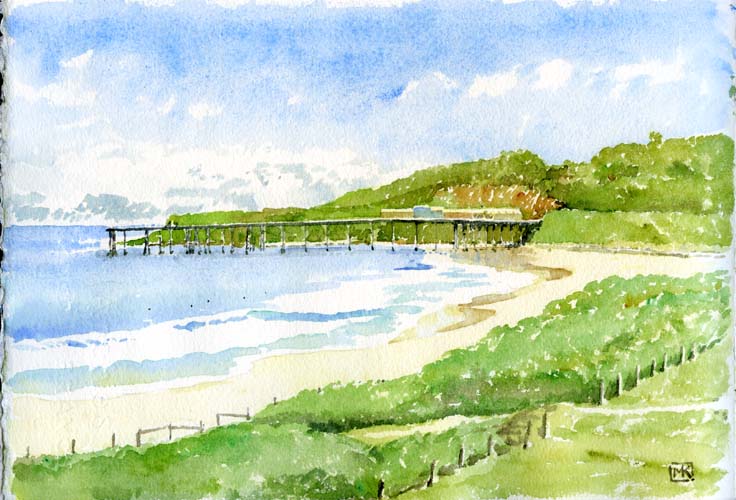
 |
(Think of the little black dots
in the distant water as body surfers.) Catherine Hill Bay is a
former mining town on the New South Wales coast south of the big
industrial city of Newcastle. Its coastline is a natural
conservation area, with ruins of the coal-loading works
concentrated on the headland in the distance (above). The town
itself is several streets of 19th century weatherboard cottages,
with a pub in the middle (of course). All of it was
supposedly protected by State heritage legislation, but the Labour
government amended the Planning Act in 2008 to allow development
in areas it deemed significant to the public interest; ergo, the
mining company, which owns a lot of land in the vicinity, has
successfully lobbied for rezonings for a new resort/residential
community that would completely dwarf the existing town and
threaten the natural landscape.... The painting above went into my book Here & Gone. |

Surf fisherman at Mona Vale Beach near Sydney, also in my book Here
& Gone.
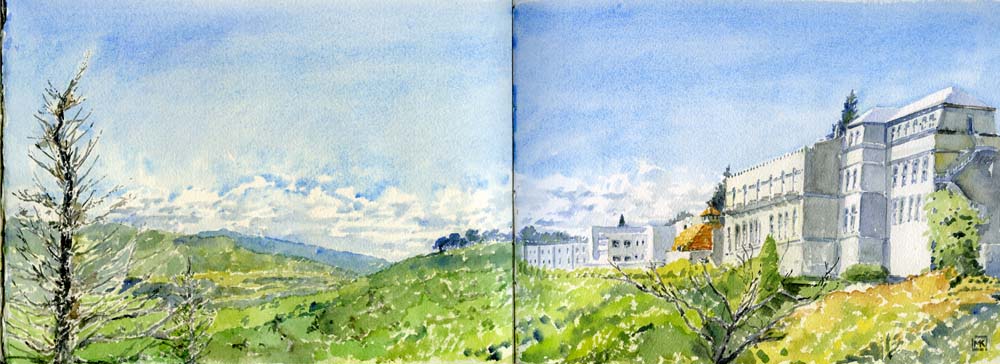
Above: the rambling old Hydro Majestic Hotel stands on the edge of the escarpment above the Megalong Valley, about 10 km. west of where we live in Katoomba. It's the centrepiece of the hamlet of Medlow Bath, whose mineral springs became the raison d'Ítre for the hotel after the railway went through in the late 19th century. The copper roof covers the casino, a prefabricated building imported from Chicago about 1904 by Mark Foy, a department store magnate in Sydney. |
 In addition to the stations at each
town in the mountains (nearly 20 of them) and the big hotels at
Medlow Bath and in Katoomba (the Carrington), there are other
historic relics of the railway era. There are still three
surviving gatekeepers' cottages along the tracks, each with a
date of 1867 or 1868 carved in stone on their front gables. They
are tiny cottages, built of sandstone with classic Victorian
punched fascia boards.
The one on the right is at Mount Victoria. The one above is at Medlow Bath, a few hundred metres from the Hydro Majestic. Below: a brush drawing I did in 2001 of the tiny Medlow Bath railway station. 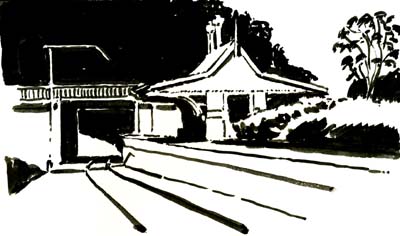 |
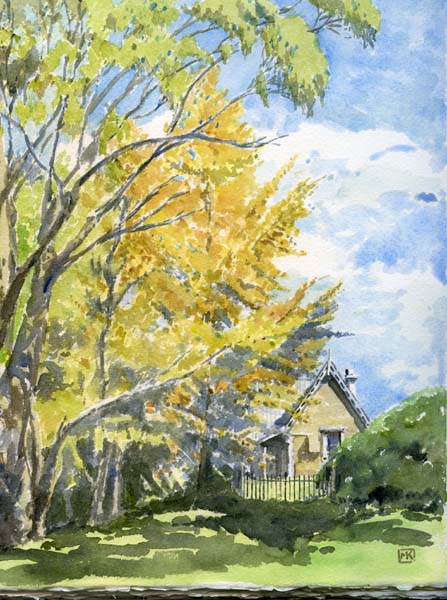 |
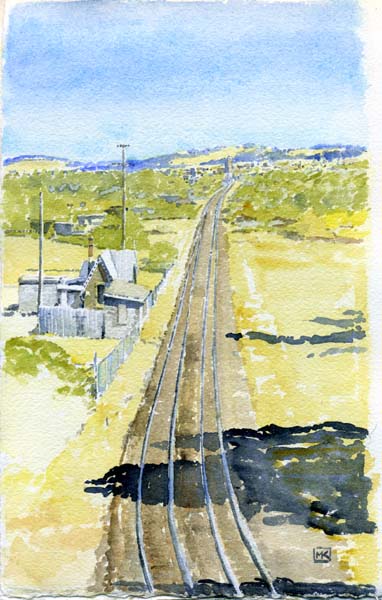
Another of the gatekeepers' or stationmasters' cottages, this one on the northern edge of Goulburn,
the large town southwest of Sydney that was the first inland settlement of the colony of New South Wales.
The railway reached Goulburn from Sydney in 1855. In my book Here & Gone.
Below: wintertime -- the flood plain of the Mulwarree River southeast of Goulburn, along which sits the Goulburn Brewery, the oldest working industrial complex in Australia.
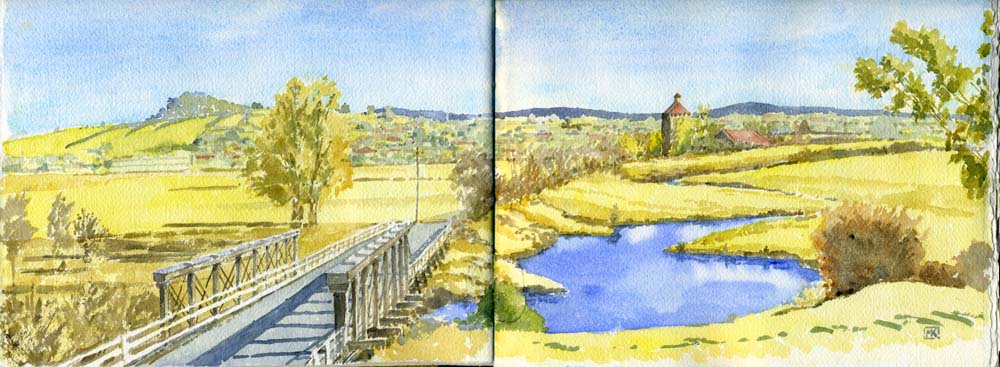
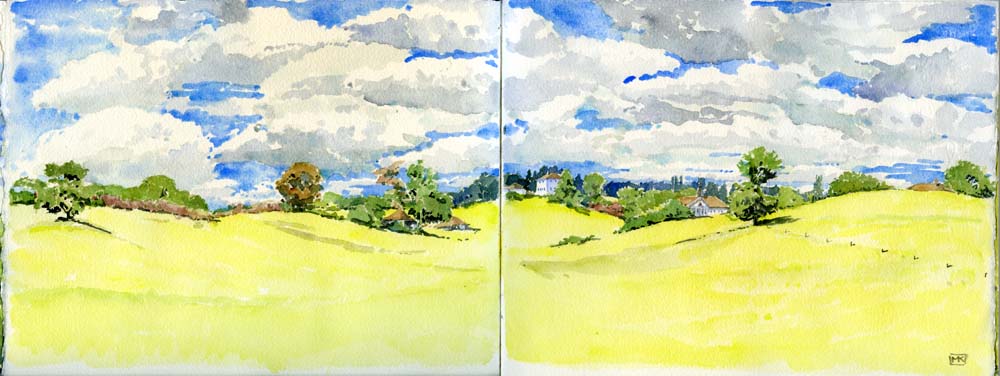
| A few hour's drive west of the mountains near Wylong, in the rolling countryside before the western plains begin, the buildings of an abandoned Fairbridge School sprawl across a hillside above its dried-out paddocks. The Fairbridge schools were akin to the Bernardo system of scooping up underprivileged, unwanted children from the slums of England and settling them in residential schools and with farm families in the colonies (including in Canada). Naturally, there were some bad apples – a recent book here set out to detail the abuse and heartbreak experienced by some of the children. |
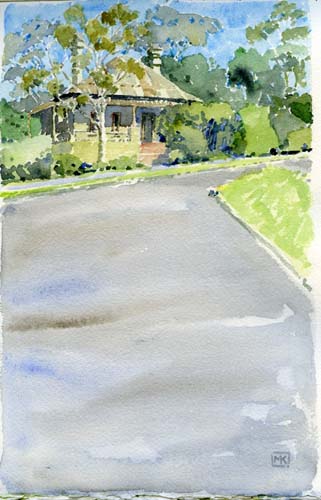 |
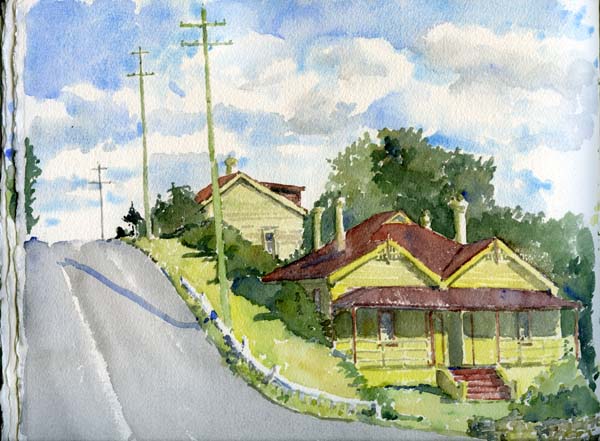 Closer to home, it's hard not
to paint the distinctive mountain cottages, usually weatherboard
(horizontal drop siding) but sometimes sandstone, most of them a
century or so old, that line Katoomba's hilly streets. These two
little daubs are of cottages on Cascade Street, within a few
minutes' walk of home.
|
Oils from 2007
|
The pictures below are my early attempts at oil painting here. I didn't do any "Australian" oil painting for much of 2008, focusing instead on writing and watercolour/illustration projects such as the ones above. As I finished paintings I put them up here -- sometimes they get pulled down, changed, then put back up or destroyed. |
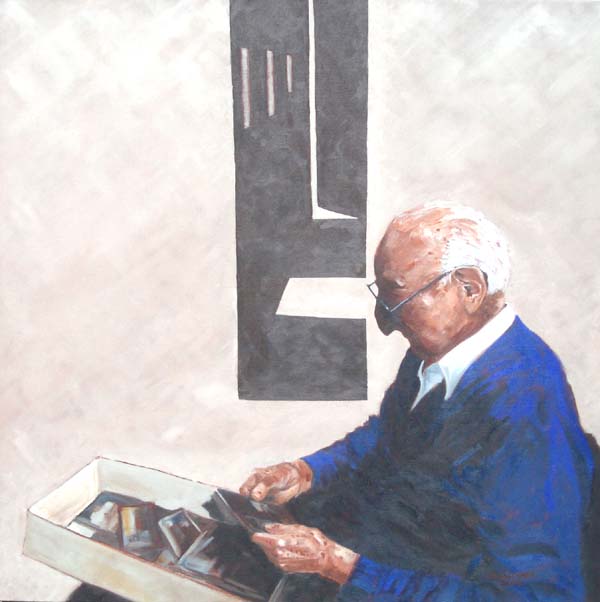
Kenneth Wilberforce Tribe at 93
Oil on linen, 101 x 101 cm, 40 x 40 inches
(This is the painting entered -- unsuccessfully -- in the Archibald Prize)

Mist Rising in the Gully
Oil on canvas 3 panels: .6 x 2.1 m 24 inches x 7 feet
Decorative panels of the scene out the back windows of our house
 |
Tourist
Map of Lue Oil on canvas 91 x 61 cm 36 x 24 inches The first of a series of pictures inspired by Lue, a dot on the map near Mudgee. DESTROYED, I THINK |
 |
Distant
Rain Oil on canvas 50 x 40 cm 20 x 16 inches .... talking with the guy who was laying tiles on our front porch. He would have been the 4th generation of his family to farm a piece of property out west near Wagga Wagga, but he didn't like the uncertainty and left the country to get a trade. His parents had been watching thunderstorms drop life-giving rain, but randomly across the landscape, for years. This year they threw all their savings into a last-ditch attempt to get a profitable crop, but the lack of rain for the past few months meant the grain would only be usable as hay. So they cut it. As it lay in the field, it began to rain, ruining it. |
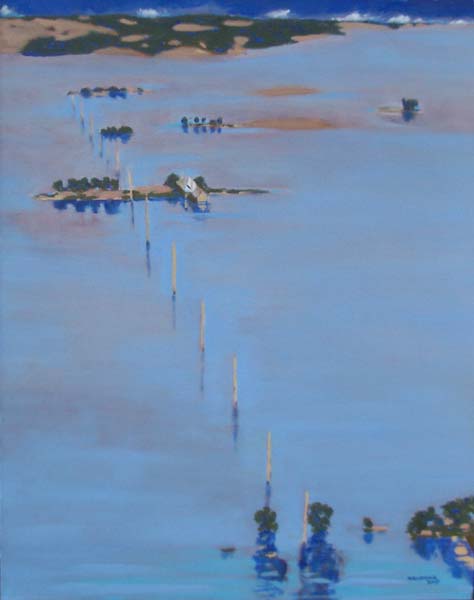 |
Climate
Change #1 Oil on canvas 76 x 21 cm (30 x 24 inches) This is a fantasy based on some of the TV pictures of flooding over the past several months, first in Bangladesh, later in the Hunter Valley. I was both fascinated and appalled by the way floodwaters beautified the landscape, reducing the randomness of the human and natural landscape to a flat pattern. DESTROYED |
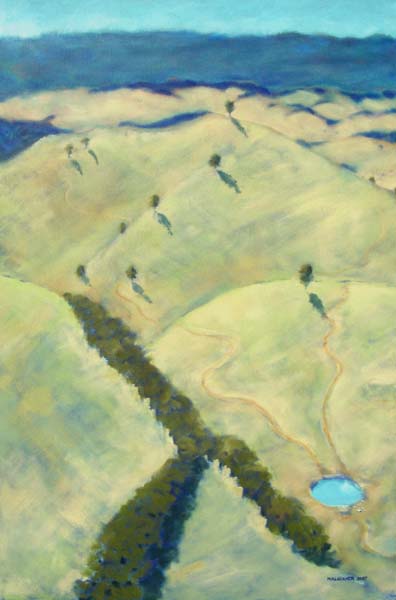 |
Songlines
for Sheep August, 2007 Oil on canvas 76 x 50 cm (30 x 20 inches) Another map-like long high view. Sheep must have songlines too, and like the Aboriginal ones from the Dreamtime (see, for example, the wikipedia entry) the pathways have a lot to do with finding water. Based on a sketch from the roadside on the road to Oberon in the western part of the Blue Mountains. SOLD |
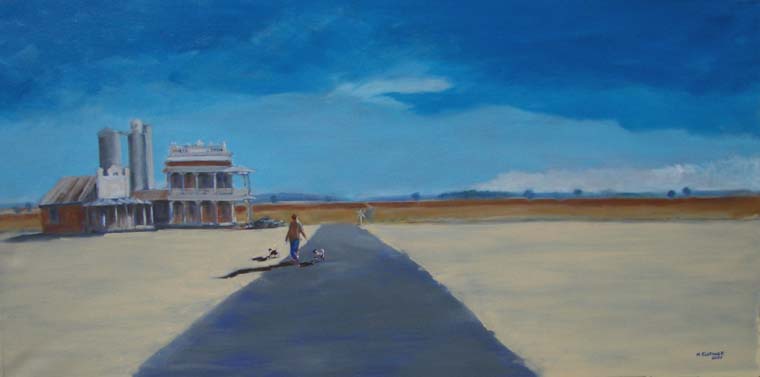
Drought Town, oil on canvas, 18 x 36 inches (46 x 92 cm.) A fantasy based on our trip through the dry wheat belt of New South Wales in May.
DESTROYED
Sketch of Lawson to Remember It By, 2007, oil on canvas, 10 pieces, 10 x 120 inches (25 cm by 3 m.)
(Lawson is 4 towns east of Katoomba toward Sydney – its shopping street is going to be wiped out for a highway widening....)
2010 update: not much left...
Winner of the People's Choice Award at the Blackheath Art Prize Spring Exhibition.
"And to have them go, not in some violent cataclysm, an act of God, or under the fury of bombardment, but in the quiet way of our generation: by council ordinance and bylaw, through shady land deals; in the name of order and progress, and in contempt (or is it small-town embarrassment?) of all that is untidy and shabbily individual."
-- David Malouf, writing about his home-town, Brisbane, in the Review, Weekend Australian, September 8-9, 2007.
Free DHTML scripts provided
by
Dynamic Drive
Artwork and text ©Michael Kluckner 2007-9
Return to home page
